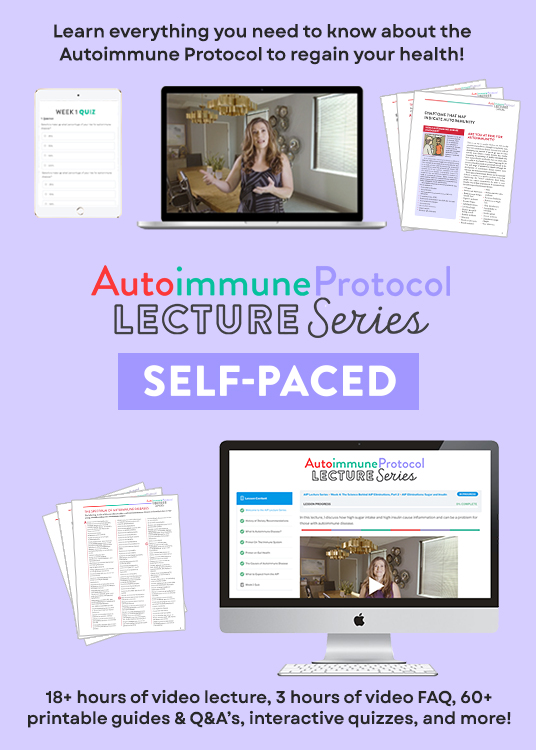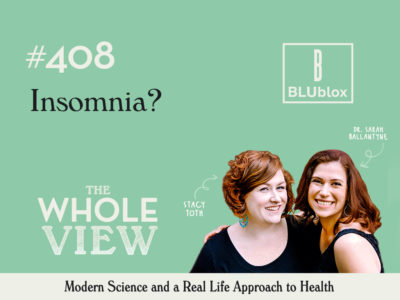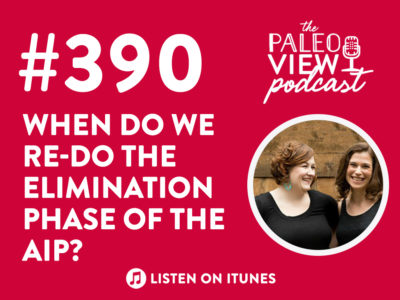Welcome to episode 408 of The Whole View. On this week’s episode, Stacy and Sarah address a listener’s question on insomnia. What exactly is insomnia? What causes it? How do you treat it? And how can you prevent it? All of this and more below. Enjoy!
Table of Contents[Hide][Show]
- The Whole View, Episode 408: Insomnia?
- Listener Question
- What is Insomnia?
- Symptoms
- How Common is Insomnia?
- Racial Disparities in Insomnia
- What Are the Causes?
- Treating Insomnia
- Drug-Free Treatment Strategies
- Additional Components of CBT-I
- Exercise Interventions
- Mindfulness Intervention
- Amber-Tinted Glasses
- Closing Thoughts
- Diet & Sleep
If you enjoy the show, please review it on iTunes!
The Whole View, Episode 408: Insomnia?
Welcome back to the Whole View, episode 408. (0:27)
Stacy has a feeling she is not the only one struggling to get quality sleep right now.
So she is looking forward to covering this week’s show topic on insomnia.
We dove previously into sleep with episode 399 when we talked about amber glasses.
Stacy has been using her BLUblox glasses five times a week, and the nights she sleeps well coincides with those nights when she is using them.
Speaking of, let’s take a moment to thank this week’s sponsor, BLUblox.
We have a code for the Whole View listeners to receive 15% off their order using this link and the code THEWHOLEVIEW.
Stacy also wants to point out that the prices you see online are Australian prices.
So by the time you do the conversion if you are American using US dollars, using the code provided, it makes a significant difference in the price.
Save 70% Off the AIP Lecture Series!
Learn everything you need to know about the Autoimmune Protocol to regain your health!
I am loving this AIP course and all the information I am receiving. The amount of work you have put into this is amazing and greatly, GREATLY, appreciated. Thank you so much. Taking this course gives me the knowledge I need to understand why my body is doing what it is doing and reinforces my determination to continue along this dietary path to heal it. Invaluable!
Carmen Maier

Stacy feels that the science of quality sleep makes these glasses worth the investment if you are looking to biohack your sleep cycle.
Listener Question
This week we have a really awesome question from Caroline that Sarah felt was a great way to talk about sleep. (2:54)
Any long-time listener is probably pretty aware that sleep is really important.
However, Caroline’s question gets to one of the bigger challenges surrounding the challenges with insomnia.
Caroline says, “First, I want to let you ladies know that I really appreciated last week’s podcast.
As a long time listener, I was really glad you both chose to speak out.
I know times are crazy right now, (Thank you for all your timely Covid-19 shows too) and this may not be a current topic of interest, but I would love an episode all about insomnia.
I know you ladies have spoken a lot about the importance of sleep on the podcast but what about those of us who actually suffer from insomnia?
It’s been worse than ever this past week. Is there help for those of us who spend hours getting to sleep only to wake up a few hours later and not be able to get back to sleep?
Thank you again for all the work you both do.”
This question is so timely!
For those who are just listening to this week’s podcast, Caroline is referring to this podcast episode from last week.
What is Insomnia?
Sarah thinks that a lot of people suffer from insomnia without recognizing it as that term. (6:22)
Insomnia is a condition that is diagnosed purely based on symptoms.
There is short-term insomnia and chronic insomnia.
Chronic insomnia is something that lasts at least three months, in which you have symptoms at least three days a week.
In this scenario you would have one of the following symptoms: difficulty falling asleep, difficulty staying asleep, waking up in the morning earlier than desired, having some kind of resistance to going to bed on an appropriate schedule, and difficulty falling asleep without a partner or caregiver.
Short-term insomnia is the same thing but lasts less than three months.
So again, showing any of those symptoms three times a week.
These symptoms at that frequency are very common.
There are predisposing factors that make you more likely to have insomnia.
For chronic insomnia, one of the biggest predisposing factors is chronic stress.
There are personality features associated with chronic insomnia.
Various conditions are linked to insomnia as a condition, such as mood and anxiety disorders.
Obstructive sleep apnea, restless leg syndrome, chronic pain conditions, and alcohol and drug abuse are all other examples of health conditions that carry insomnia as a symptom.
External factors can also cause insomnia, such as having an undesirable sleep environment.
The predisposing symptoms for short-term insomnia are pretty much the same things.
Short-term insomnia can even be a presenting thing of other underlying conditions.
Symptoms
Insomnia is diagnosed with the symptoms of not being able to fall asleep and not being able to stay asleep. (10:30)
Not being able to sleep long enough is also part of the diagnosis equation.
There are other symptoms that are the consequence of that inadequate sleep.
Symptoms of insomnia include not feeling well-rested when you wake up, feeling tired during the day, irritability, is a trigger for depression and anxiety, can hinder cognitive abilities, and ongoing worry about sleep.
It can end up being this endless snowball bad effect, where the stress of not sleeping, erodes sleep, which then magnifies stress.
How Common is Insomnia?
Insomnia is ridiculously common. (12:03)
The prevalence of both acute and chronic insomnia in multinational cohort surveys has varied from 3.9% to 22%, depending on the definition used and the age group studied.
When using the ICSD-3 diagnostic criteria the prevalence of chronic insomnia is 9% to 12% with transient symptoms of insomnia reported in 22-35% of the population.
Racial Disparities in Insomnia
Given the very strong between insomnia and stress, it shouldn’t be a surprise that there are racial disparities in insomnia. (15:12)
Black Americans are approximately 67x more likely than whites to have insomnia.
This study published in 2016 took a look at racial disparities in sleep.
They looked at all of these other chronic illnesses that are linked with inadequate sleep.
So what they found is that the lack of sleep itself was what was linking the chronic illnesses.
You could actually predict the occurrence of chronic illnesses based on sleep.
We talked last week about the Black community being much more high risk of chronic illnesses.
You can draw the same line of systemic racism increasing stress, making it more likely for any of those predisposing factors to exist, and that being responsible for people of color, in general, being much more likely to not get enough sleep.
And not get enough sleep whether or not they technically have insomnia.
So what is really interesting is when you take insomnia out of the question, Black Americans are still more than twice as likely to not get enough total sleep compared to white Americans.
What is fascinating is that this particular study was able to show that the lack of sleep is the thing that is contributing to racial disparities in chronic illness.
There was another really fascinating paper that followed people over 10 years and looked at how insomnia changes over time.
There were able to show that for white and non-Hispanic and Black people in their cohort, the accumulation of insomnia was very tied with health conditions.
However, in Hispanics, it increased disproportionality.
The Hispanic population saw a much more dramatic increase in insomnia with age.
When you corrected for all these health conditions, it was still there.
This is an interesting racial disparity in the sense that it really points to some kind of chronic stress for being a contributor.
What Are the Causes?
Insomnia is a fairly unique chronic illness, in the sense that there is not a marker that we can pinpoint. (20:38)
It really is like a behavioral symptom in some ways.
However, it is a consequence of things like stress or having a travel/work schedule that is messing with your internal clock.
You can have insomnia without melatonin being diminished.
It really is some of all of these different factors.
Insomnia can be the direct result of poor sleep habits.
Examples include evening snacking, screen time too close to bedtime, and uncomfortable sleep conditions.
This condition that we give a name to is really a culmination of the effects of stress, plus behavioral or routine type contributors to how our body prepares for sleep and initiates sleep.
Stacy shared a look at how Matt’s medications impact his sleep cycles.
Sarah noted that there are a lot of medications that can interfere with sleep.
Many antidepressants, medications for asthma and lower high blood pressure, cold and allergy medications, and the weight loss magic pills are also filled with stimulants.
Caffeine, nicotine, and alcohol are all very well known to disrupt sleep.
It is worth having a conversation with your healthcare provider about other options if you suspect that your medication is impacting your sleep.
There are some medical conditions where you will not be able to get around that, like ADHD medication.
Stacy shared a look at how Matt was able to modify his ADHD medication to improve his sleep quality.
It is a priority for all medical professionals to ensure their patients are sleeping.
So if your not, please let them know and work on that.
It is always ok to ask your doctor questions if something doesn’t feel right to you.
Treating Insomnia
When it comes to treatments there are basically sleeping pills and nonpharmacologic options. (29:11)
There are basically side effects of every sleeping pill option AND they are almost all habit-forming AND they are not as effective as drug-free treatments.
Every single option has pretty awful side effects that impact the majority of people.
These are side effects that are broadly experienced and can include things like dry mouth, upset stomach, headache, dizziness, and sleepiness throughout the day.
There are many scary stories about those who have done things at night while asleep with no memory of what they had down the night before.
Stacy noted that they have experienced no symptoms with melatonin.
Matt and Stacy have found it to be a helpful tool without side effects.
Sarah referred listeners back to the melatonin show for more information on where melatonin can be really helpful.
It is really helpful in circadian rhythm dysregulation conditions.
Stacy shared examples from her personal experiences in her family where they see a ripple effect in disruptions in their sleep routines.
She also shared examples of ways they positively reduce sleep disruptions and improve sleep habits.
Sleep is very important to health, but it takes consistency.
When stress is high, you have to be all the more diligent about focusing in on those sleep habits.
You can’t decide one day to fix your sleep habits and then all is fine.
These are habits you will always need to be mindful of.
Drug-Free Treatment Strategies
Cognitive-behavioral therapy for insomnia (CBT-I) has shown to be more effective than drugs, over and over and over again. (38:15)
There is a huge number of clinical trials showing hands down CBT-I is the most effective treatment for insomnia.
For more on this, see here and here.
CBT-I is typically done in a group therapy setting, but it can also be done one on one.
It is typically a couple of hours a week.
What is does, is that it basically looks at the causes of insomnia and what can be mitigated.
It has a variety of different components.
One component that studies have separated out and shown that this is a really important part of how CBT-I works is called sleep restriction therapy.
What this does is recognize is the homeostatic drive for sleep.
We have these chemicals that build up in our brain throughout the day that eventually make us feel really sleepy at night.
When we sleep it flushes those chemicals out.
Caffeine inhibits the ability of those chemicals to bind, which is why caffeine makes us feel more awake.
So sleep restriction therapy basically tries to reset that homeostatic drive for sleep by cutting naps and setting a late for you bedtime.
Additional Components of CBT-I
Another aspect of CBT-I is called stimulus control instructions.
This basically looks at sleep habits and pinpoints different things that you might be doing to overstimulate in the evening that may be inhibiting sleep.
And this includes sleep hygiene education.
So there would be a whole list of things that are customized to you that are essentially your yes and no list.
These are all habits that we discuss on this show.
One of the things that they will always instruct you to do is to sleep on a consistent schedule.
This is because of the hormone regulation that is controlling sleep.
Another part of CBT-I is relaxation training, which often involves mindfulness practice.
There is something that they teach to help people remain actively awake.
The last piece of CBT-I is biofeedback.
You might do this with some kind of tracker or observe your own levels of muscle tension.
These strategies may be incorporated into a mindfulness practice.
The idea is to be able to understand your daily patterns of markers that might be reflected in your sleep quality.
Exercise Interventions
One of the things that can be layered on to the CBT-I practices is exercise interventions. (43:49)
Exercise interventions have been studied as part of CBT-I and separately.
One of the old school recommendations for not exercising before bed has been debunked in the scientific literature.
They have basically found that there are certain people who exercising in the evening will disrupt their sleep.
However, as a general rule, it is not the case.
Exercising helps support sleep.
There are a bunch of studies showing that aerobic exercise, compared to resistance training, is very good for supporting sleep.
Even thirty minutes, three times a week show a modest effect, but still a measurable effect.
So this can often be part of CBT-I.
For most people, research has found that it matters more that exercise is regular and on a schedule than what time of day it is.
You can learn more about this here.
Mindfulness Intervention
Keep an open mind about what falls under the umbrella of the word meditation. (46:38)
Sarah loves Stacy’s disdain for meditation when she meditates nightly.
With mindfulness and insomnia, there is basically two different approaches.
One is what is called mindfulness-based stress reduction.
This is a whole independent program that teaches meditation and is typically done in group classes.
There is mindfulness-based therapy for insomnia, which basically incorporates that mindfulness practice into CBT-I
What has been really interesting to see is that mindfulness all by itself is very effective.
However, it is even more effective when combined with CBT-I.
Mindfulness by itself has been shown to be just as effective if not more effective than drugs.
And there seems to be this better effect when you combine it, especially long-term.
Amber-Tinted Glasses
The last thing that can be layered with CBT-I, which has been shown in a couple of recent studies to be very effective, is wearing blue-blocking glasses. (49:54)
One study that was published in 2018 took 14 people with insomnia and they had them either wear blue-light blocked amber lenses or placebo lenses for two hours before bedtime for seven consecutive nights.
What they showed was that there was a marked improvement in total sleep time for the people wearing the amber glasses.
They did a variety of different measures to reach this conclusion.
Amber glasses actually made a large difference to sleep quality and total sleep time in just seven days.
Another study that was just published in February 2020 layered amber-glasses on top of CBT-I.
They had 30 patients all with chronic insomnia.
And they all went through the same CBT-I group therapy program.
Again, they were randomly assigned to either have blue-light blocked glasses or placebo.
And they again had all these different ways of measuring sleeping, including wrist actigraphy.
They also compiled scores looking at anxiety, depression, and quality of life in general.
So they were also looking at symptoms for chronic sleep deprivation.
They found that the group that had the amber glasses had a really huge improvement in how many minutes they were sleeping.
Whereas, the people who did the CBT-I alone and had the placebo glasses, actually over the period of time that they were watching these patients, actually had their sleep get worse.
The amber-tinted glasses group had a really significant improvement in their various measurements in sleep and their measurements in anxiety, depression, and the hyperarousal score.
They were basically able to show that not only sleep time was improved, that all of these other markers of sleep quality were also improved.
Between these two studies, we show that blue-blocking glasses by themselves can be very very helpful.
They are even more powerful when combined with this more comprehensive, holistic approach to addressing insomnia.
Closing Thoughts
Stacy knew at the top of the show that she was going to be reminded of all of the reasons why sleep hygiene is important and what she can do better.
She is really grateful that we took the time to revisit this.
And also appreciates all the work that Sarah did to dive deeper into the research on this.
Stacy shared more on how stress builds up in her life and eventually compounds within both her sleep quality and quantity.
She personally experiences good results when she takes magnesium before bed, as well as wearing blue-blocking glasses.
Putting her kids to bed at a regular time is also critical.
If you are a parent, letting the kids stay up later can contribute to poor sleep habits.
Stacy doesn’t think everything can be solved without medicine, but she does think that before jumping into that there are a lot of behavioral and lifestyle factors that we can choose to do.
Diet & Sleep
The other idea that Stacy and Sarah wanted to revisit is the importance of not being low-carb before bed.
When it comes to habits to support sleep, this is one that is very important.
There is a very strong link between diet, meal timing, and sleep quality.
Eating a higher fiber diet and moderate fat has been shown to decrease the amount of time it takes to fall asleep.
It also improves the quality of sleep in people.
A slow-burning starchy carb at dinner has been shown to be very very helpful for sleep.
Low-carb diets have been shown to disrupt sleep quality.
Part of what we can do to support sleep quality is actually eating breakfast (check out this and this podcast episode for more information on why).
Eating dinner on the earlier side is also helpful.
Ideally you want at least two hours between when you eat dinner and when you go to bed.
However, four to five hours is optimal.
The science is really compelling on an earlier dinner and actually shifting our caloric intake towards the earlier part of the day.
It is a really healthy eating pattern to eat a bigger breakfast and lunch and then a lighter dinner, on the early side.
If you are someone who is not drawn to large breakfast, Stacy strongly suggests listening to this podcast for recommendations.
Stacy shared her personal experience with the benefits she experienced when she shifted her meal timing.
Listeners, don’t forget if you want to check out the blue-light clocking glasses that we recommend, please visit BLUblox.
Use the code THEWHOLEVIEW for 15% off.
Thanks for listening!
We will be back again next week. (1:08:21)










